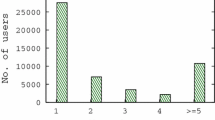Abstract
Public shaming is mass criticism of someone for perceived violation of an established social norm. These events are ever increasing in number and scope on online social media platforms. An individual instance of shaming is, as a matter of fact, an expression of opinion regarding the target or victim of the event. Public shaming events are more engaging and often evoke stronger opinions from users than word of mouth spreading of information. This work models polarity of a user’s opinion as a function of several factors, such as his/her recently held opinions, received opinions and the environment, in online public shaming events on Twitter. Specifically, we investigate the opinion change process of Twitter users by highlighting the influence of responsible factors. A semi-supervised representation learning model is used to get opinion vectors from tweets. Next, an opinion prediction model based on the user’s past opinions, received opinions and environment is designed. We show that opinion changes can be attributed to factors in varying proportions depending on the direction of the change. Thus, a strategy to stop a shaming event by inducing opinion changes in the participants needs to take into account the direction of the change. Efficacy of possible counter measures to shaming is analyzed based on our findings.






Similar content being viewed by others
Notes
References
Bakshy E, Hofman JM, Mason WA, Watts DJ (2011) Everyone’s an influencer: quantifying influence on Twitter. In: Proceedings of the fourth ACM international conference on web search and data mining, pp 65–74
Basak R, Sural S, Ganguly N, Ghosh SK (2019) Online public shaming on Twitter: detection, analysis, and mitigation. IEEE Trans Comput Soc Syst 6(2):208–220
Baumann F, Lorenz-Spreen P, Sokolov IM, Starnini M (2019) Modeling echo chambers and polarization dynamics in social networks. arXiv preprint arXiv:190612325
Bredereck R, Elkind E (2017) Manipulating opinion diffusion in social networks. In: IJCAI, pp 894–900
Castellano C, Muñoz MA, Pastor-Satorras R (2009) Nonlinear q-voter model. Phys Rev E 80(4):041129
Cha M, Haddadi H, Benevenuto F, Gummadi KP (2010) Measuring user influence in Twitter: the million follower fallacy. In: Fourth international AAAI conference on weblogs and social media
Chen X, Lijffijt J, De Bie T (2018) Quantifying and minimizing risk of conflict in social networks. In: Proceedings of the 24th ACM SIGKDD international conference on knowledge discovery and data mining, pp 1197–1205
Clifford P, Sudbury A (1973) A model for spatial conflict. Biometrika 60(3):581–588
Deffuant G, Neau D, Amblard F, Weisbuch G (2000) Mixing beliefs among interacting agents. Adv Complex Syst 3(01n04):87–98
Devlin J, Chang MW, Lee K, Toutanova KN (2018) Bert: pre-training of deep bidirectional transformers for language understanding. arXiv:181004805
Goldenberg J, Libai B, Muller E (2001) Talk of the network: a complex systems look at the underlying process of word-of-mouth. Mark Lett 12(3):211–223
Granovetter M, Soong R (1983) Threshold models of diffusion and collective behavior. J Math Sociol 9(3):165–179
Guerra PC, Nalon R, Assunção R, Meira Jr W (2017) Antagonism also flows through retweets: the impact of out-of-context quotes in opinion polarization analysis. In: Eleventh international AAAI conference on web and social media
Hegselmann R, Krause U et al (2002) Opinion dynamics and bounded confidence models, analysis, and simulation. J Artif Soc Soc Simul 5(3):1–33
Jedrzejewski A, Sznajd-Weron K (2018) Impact of memory on opinion dynamics. Phys A Stat Mech Appl 505:306–315
Kelman HC (1958) Compliance, identification, and internalization three processes of attitude change. J Confl Resolut 2(1):51–60
Kempe D, Kleinberg J, Tardos É (2005) Influential nodes in a diffusion model for social networks. In: International colloquium on automata, languages, and programming. Springer, Berlin, pp 1127–1138
Matakos A, Terzi E, Tsaparas P (2017) Measuring and moderating opinion polarization in social networks. Data Min Knowl Discov 31(5):1480–1505
Morales A, Borondo J, Losada JC, Benito RM (2015) Measuring political polarization: Twitter shows the two sides of Venezuela. Chaos Interdiscip J Nonlinear Sci 25(3):033114
Olivares G, Cárdenas JP, Losada JC, Borondo J (2019) Opinion polarization during a dichotomous electoral process. Complexity 2019:1–9
Prasetya HA, Murata T (2020) A model of opinion and propagation structure polarization in social media. Comput Soc Netw 7(1):1–35
Razis G, Anagnostopoulos I (2014) Influencetracker: rating the impact of a Twitter account. In: IFIP International conference on artificial intelligence applications and innovations. Springer, Berlin, pp 184–195
Rogers EM (1962) Diffusion of innovations. Simon and Schuster, New York
Ronson J (2015) So you’ve been publicly shamed. Picador, London
Su W, Guo J, Chen X, Chen G (2019) Noise-induced synchronization of Hegselmann–Krause dynamics in full space. IEEE Trans Autom Control 64(9):3804–3808
Sundararajan M, Taly A, Yan Q (2017) Axiomatic attribution for deep networks. In: Proceedings of the 34th international conference on machine learning, vol 70, pp 3319–3328. JMLR.org
Sutskever I, Vinyals O, Le QV (2014) Sequence to sequence learning with neural networks. Proceedings of advances in neural information processing systems 27:3104–3112
Weng J, Lim EP, Jiang J, He Q (2010) Twitterrank: finding topic-sensitive influential twitterers. In: Proceedings of the third ACM international conference on web search and data mining, pp 261–270
Author information
Authors and Affiliations
Corresponding author
Additional information
Publisher's Note
Springer Nature remains neutral with regard to jurisdictional claims in published maps and institutional affiliations.
Rights and permissions
About this article
Cite this article
Basak, R., Ghosh, S.K. & Sural, S. Influence modeling of opinion switching by Twitter users in public shaming events. Soc. Netw. Anal. Min. 10, 84 (2020). https://doi.org/10.1007/s13278-020-00698-9
Received:
Revised:
Accepted:
Published:
DOI: https://doi.org/10.1007/s13278-020-00698-9




